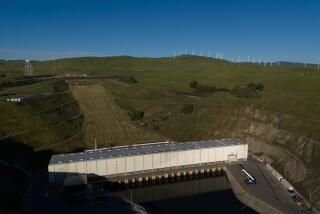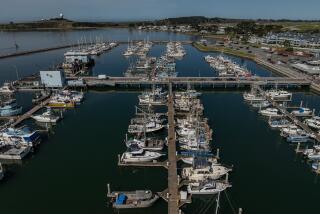Arizona Desert Not Too Dry for Fish
- Share via
TUCSON, Ariz. — Arizona’s searing desert climate can prove inhospitable for everything but the lizards and snakes that thrive among the cactus and the spiny, yellow-flowered catclaw.
But people like Gary Wood are trying to reel in a profit from an unlikely source: fish and shrimp farming.
“Everyone told us we were crazy,” Wood said.
Wood, his father and uncle have been raising shrimp on their Wood Bros. Farm near Gila Bend in southern Arizona since the mid-1990s.
The farm, which grows grains and cotton, usually produces less than 100,000 pounds of shrimp annually. But this year, with its shrimp ponds doubled in size to more than 50 acres, Wood expects to harvest more than 500,000 pounds.
Overall, Arizona aquaculture brought in nearly $3.3 million last year as farmers raised 1.3 million pounds of striped and largemouth bass, catfish, tilapia and trout and 168,000 pounds of shrimp. The industry is worth $1 billion nationally.
Arizona has 30 licensed fish farms or facilities. The state’s residents eat an average of 10 pounds of fish each year, a total of 51 million pounds, and farmers predict demand will continue to increase.
“It could easily grow to a $50-million industry in 10 years,” said Kevin Fitzsimmons, aquaculture extension specialist for the University of Arizona’s Environmental Research Laboratory.
A decade ago, the thought of a thriving fish-farming industry would have been ridiculed. Most of the fish-farming ventures by ill-prepared entrepreneurs failed.
In the early 1980s, the Wood family successfully managed a shrimp farm in Ecuador but had to reeducate themselves when they tried to make a go of it in Arizona, Wood said.
They discovered that the sun and the fresh water from an underground aquifer near the Gila River make their common Pacific white shrimp grow huge and sweet.
“What makes farming in Arizona so great is the fact that with the sunlight and the algae production from it, the shrimp just explode and with great taste,” he said.
Arizona growers have also been able to keep their shrimp stock free from diseases that originate in the ocean, some of which have devastated shrimp populations in Asia and Latin America in recent years. Shrimp grow in both fresh and salt water.
“It’s a great place to produce shrimp because it’s not on the seacoast and you don’t have the disease problems,” said C.M. Shaar, managing member of the Dateland-based Arizona Mariculture Associates, a shrimp-farming venture in its second year of operation.
Josh Wilkenfeld, Arizona Mariculture’s operations manager, said some 15,000 to 20,000 acres between Gila Bend and Yuma could potentially be developed for shrimp farming. The land sits above a large supply of underground water free of bacterial problems and relatively free of viral diseases, he said.
Some operations like Wood’s and Oliva’s get double use of their water by irrigating fields of other crops, like olive trees and wheat, with the nutrient-enriched water from their fish ponds.
More to Read
Sign up for Essential California
The most important California stories and recommendations in your inbox every morning.
You may occasionally receive promotional content from the Los Angeles Times.










